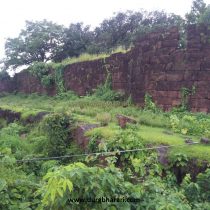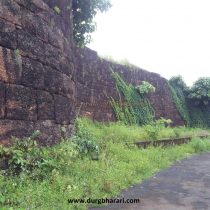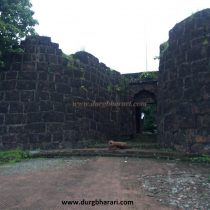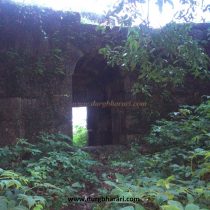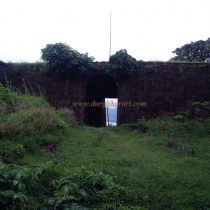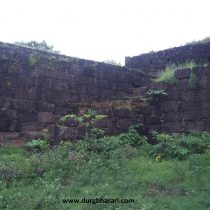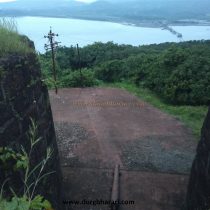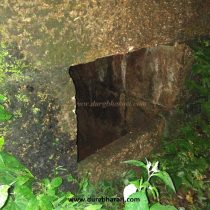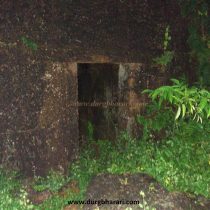BANKOT
TYPE : COASTAL FORT
DISTRICT : RATNAGIRI
HEIGHT : 0
GRADE : EASY
Bankot is the northernmost point of the Ratnagiri district. The fort of Bankot is built on a hill at the mouth of the creek on the south bank of the river Savitri. The fort is still in good condition. An important naval station was previously situated at the mouth of river Savitri. A Ganpati temple and a well are located at the foothills of the fort. As there is a paved road directly from Bankot village to the fort, one can go directly to the fort gate. A moat has been dug on the lower sides of the fort to prevent easy access to the ramparts, but it is now covered with stones, soil, and bushes. The fort has a simple rectangular shape with an area of 1 acre and a total of seven bastions on the ramparts of the fort. The ramparts of the fort are 8 feet wide and 30 feet high and the north-facing entrance of the fort is built with two bastions on the west side of the sea.
...
One of the cannons is aimed at the sea at the entrance of the fort. The gate of the fort is a dome with beautiful stone arches and even today the arch of the entrance is lined and in good condition. The ramparts and bastions are built one on the other on a limestone slab of rectangular stone. Upon entering the fort, round spacious porches are visible for the guards on both sides. On the porch on the right, there are six small cisterns built with a small wall. Judging by the work of these tanks, it seems to be of recent times. To the right of the entrance is a toilet in the rampart and spacious open space in front. There are a lot of ruins in the yard and some places there are carved broken stones. There should have been a temple in this place as a Maruti idol can be seen in the piled stone. Elsewhere, there are some ruins of buildings left. Mango and other big trees are growing in this fort. On the inside of the door is a spacious stone staircase on the left to climb the wall. When you come up with this staircase, you can see the confluence of the river Savitri and the sea and the surrounding area from the upper part of the door. There are 2 more staircases on the east-west side to climb the fort. Each of the bastions has a large cannon barrage, but the cannons are not present there except for one cannon in the doorway. The ramparts and bastions of the fort are covered with tree roots and should be pruned. Another small gate of the fort can be seen on the southern wall. This gate on the bank leads to the bastion outside the fort. There are steps to descend through this door. There is a deep well in this bastion which is now getting extinguished. In the inner part of this bastion on the west side, there is a guard room or ammunition depot. There is a small door leading out of the bastion. The monument at the bottom of this path is a British cemetery of the olden times. This is where your fort round ends. Due to the small size of the fort, one hour is enough to see the entire fort. From Harne-Murud to Harihareshwar-Shrivardhan, one can see the area which is very suitable for watching the sea movements. A different incident is related to this fort and the creek of the Savitri river. Around the year 1800, to reach Mahabaleshwar by sea from Mumbai, one had to go through Bankot and from there through the Savitri creek. Arthur Mallet, son of Sir Charles Mallet, Governor of Pune, left Mumbai for Mahabaleshwar in 1791. At that time, the boat carrying his 25-year-old wife Sophia and 32-day-old daughter Ellen Variet sank in Bankot Bay with 13 crew members. He was buried in the cemetery at the foot of the fort and a memorial was erected in his name. We can still see his monument in the fort's burial ground. In his memory, there is a quadrangle structure made of stone and a stone pillar on which his name was engraved. After this incident, Arthur Mallet went to Mahabaleshwar on a high bank near the source of the Savitri River and his beloved wife and daughter were resting on the other side of the river. This is the famous Point Arthur seat of Mahabaleshwar today. The name Arthur Seat is named after the same Arthur Mallet. Trade used to pass through Bankot Bay in the past. The fort was built at the mouth of the river Savitri to protect the trade route. The fort of Bankot has stood for centuries, protecting Bankot Bay. In the first century, the Greek historian Pilni referred the fort to as Mandgor or Mandagiri. The history of this fort is not available till 1548, but its history dates back to the fifteenth century. From Bijapurkar, the fort came to the Portuguese in 1548 and then to the Marathas in the middle of the 16th century. During Shivaji Maharaj’s period, this fort was under the Adilshahi rule. Later, Kanhoji Angre captured this fort and named it Himmatgad. After the assassination of Sambhaji Maharaj, Bankot and Mandangad were conquered by Janjirekar Siddi. The fort was under Siddi's control till 1733 when the Peshwas launched a campaign against Siddi. Later, in 1733, Bankaji Mahadik, a Peshwa chief, captured Bankot from Siddi, but two years later, Siddi attacked and recaptured Bankot in 1735. Later, in 1736, Pilajirao Jadhav, a brave Peshwa chief, conquered Bankot. Considering the importance of this small fort, the Marathas recruited 800 people for the protection of the fort. Later, Bankot came under the control of Angre. After the feud between Tulaji Angre and the Peshwa, a joint force of the Peshwa and the British led by Commander James conquered the fort of Bankot. He named the fort as “Fort Victoria”. When Commander James captured the fort in 1755, nine villages in the area came under British control. Bankot fort and port were not profitable in terms of trade and the British returned this fort to the Peshwas. Later, in December 1817, with the help of Siddi, the British conquered Himmatgad aka Bankot permanently from the Marathas. Even during the British rule, Bankot fort and creek were important for shipping. During this period Bankot gained political prominence due to its trade and geographical location and became the headquarters of the district office. However, due to the inconvenience of transportation, the district office was later shifted to Ratnagiri and the importance of Bankot diminished. After descending from Bankot fort and approaching the main road, on the right-hand side, you can see a small bastion-like structure. This is one individual water tower to keep an eye on the sea. Siddi built this tower to strengthen the defense system of Bankot fort. In the past, boats were used to come here. Going along this coastal road, Bankot fort can be seen on the nearby hill while Panburuj is on the surface between the road and the sea.
© Suresh Nimbalkar

